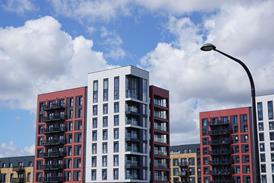If you are a stranger the occupier can speak to you via the entry phone audio link. If you are a friend, they push a button and the door opens automatically letting you in and then closes behind you. This is the smart home.
It all sounds like great techno-fun but there is a serious side to this kind of gadget. There are over 10 million people living in the UK with some kind of disability – anything from a speech impediment to blindness or mobility problems. Having devices like these helps them to live a more independent, enjoyable life.
A good quality of life for all is something that has long been championed by the Joseph Rowntree Foundation and it is involved, along with its own Housing Trust, Scottish Homes, Edinvar and the Science & Technology Policy Research, in Smart Homes, a project investigating the application of home automation and assistive technologies in affordable housing.
The project has taken shape with the conversion of two properties – a local authority flat run by Edinvar in Edinburgh and a bungalow on the Rowntree Foundation's York site. The Scottish site has been modified to house a disabled occupant while the bungalow in York is designed to make life easier for the elderly.
Each site incorporates a type of bus technology to transfer messages to the devices. In York the Lonworks Echelon system is used, while Edinburgh has a different system, the Siemens instabus EIB. Both types of communication network operate along the same lines. Messages are sent to an intelligent device (one containing microchip technology) – this could be a smoke detector, door opener, switch, socket etc – which is assigned its own address. This address enables the user to program the device via a pc and also for it to communicate with other devices on the network.
The Scotch connection
In Edinburgh, the Siemens system has a 24 V twisted pair instrumentation and control cable as its backbone. This runs throughout the building linking sensors, actuators and receivers via a bus-coupling unit (containing a microchip).
A pc is used to program the devices which will operate when commanded via an infra-red remote control handset (infra-red receivers are installed in the ceiling of each room), the push of a button, a movement sensor or a touchscreen pc. Control is not confined to one device per message. The system can be programmed for multiple operations including a bedtime mode which, at the touch of a button, closes any open windows and locks the doors. In fact, the Edinburgh flat is crammed with all kinds of mood setting and multiple action operations: light sensors detect the onset of evening, close the curtains and turn on the lights; if a window is instructed to open, the heating in that room will turn off; if the gas or smoke detectors are activated, emergency lighting comes on and the exterior doors open to aid a swift escape.
The system is linked to a control centre on the site and staff can monitor the occupant's well-being remotely using sensors installed under the carpets, as well as temperature levels in the flat.
User-friendly in York
The Bungalow in York is set up for use by the elderly. There are not as many devices installed but they do make life easier for the old aged.
Central locking of the doors and windows on leaving the flat alleviates the need to go around and check; there are push-button controlled taps and work surfaces in the kitchen that can be raised or lowered for wheelchair users; there is even a setting that activates the radio alarm clock, switches on the light, runs the bath and boils the kettle as you wake.
This technology is controlled by the Lonworks Echelon system. Again devices have a microchip installed to make them interactive. Hardwired items such as smoke detectors and window operators have it installed internally while white and brown goods are fitted with a plug containing a chip.
Again the devices are given an address and can be programmed using a pc. As with the Siemens system, commands come from a remote control pad, switches or a pc. The difference with the Lonworks Echelon system is that the messages are transported down the mains wiring to hardwired devices. Only those devices not normally mains powered, like window openers or smoke detectors, need to be connected with a lv twisted pair cable.
Techno-change
The beauty of both systems is the ease with which they can be upgraded. This is important if the technology is to be used in local authority or private properties for the old age/disabled.
Both protocols allow new devices to be added on to the network simply by using the pc to add a new 'address'. Simple Windows-based drag-and-drop programs are used to install devices and instruct them to link in with others. And, if an extension is required, twisted pair cables are simply linked to each other.
Both systems claim to be 'open', meaning that they are compatible with a myriad of different devices and products and both are supported by associations registering manufacturers who make compatible products.
The Lonmark Interoperability Association is a worldwide concern listing sponsors including Philips, Legrand, Landis & Staefa and Groupe Schneider. Partners include ECS Lighting Controls, JSB Electrical and Hitachi.
EIBA, the European Instabus Association, provides guidance on Siemens' protocol and its UK members include Legrand, Landis & Staefa, Ashley & Rock, Hager Powertech, Caradon MK, ABB/Electrium and ECS Lighting Controls to name a few.
Controlling costs
A typical installation containing a selection of the technology is estimated to cost around £5000. A similar installation designed for the elderly is said to cost about £3000.
Both figures seem high but if installed on a large scale the cost of an installation would tumble and, when compared with the cost of institutionalising someone, the payback time is extremely short indeed.
These figures have generated tremendous interest from housing associations and private concerns. Contractors should get to know about smart homes.
Get interoperable
Installation bus technology is not something that has to be solely in the realm of the specialist. The only way that technology like this can become commercially viable is by making it simple and cost effective to install and use. The European Installation Bus Association (EIBA) wants to educate contractors in order to make this technology more widely available. EIBA UK has set up a timetable of courses at its training centre in Addlestone, Surrey for contractors, system designers, project managers and the likes. The longest course is a five-day design module. It is aimed at electrical planners, installers and wholesalers and will cover installation bus technology; project design using lighting, heating/ventilation etc; installation guidelines; regulations and documentation and commissioning of installations. This course costs £900 plus vat – the cost includes course material, refreshments, lunch and an EIBA certificate. Next is the two-day course. At £360 plus vat it is considerably cheaper and aimed at project managers, engineers, planners and marketing and sales managers. Its content gives an overview of the EIBA, EIB devices, project design, commissioning and current projects and applications. Finally there is the one-day course. This costs £180 plus vat. Installation bus technology and operation are covered as are installation procedure, regulations and documentation. Installers and wholesalers will be the main subscribers. On completing a course you will become accredited by the EIBA to design, install and commission its products. The next opportunities to get on to one of the courses are as follows:What's new in lighting controls





Lutron's new Two Link option offers two distinct control links inside each GP dimming panel for improved functionality. It will also consolidate circuits in one panel for more than 64 zones in a Grafik Eye 4000 dimming system and can also be used to integrate two redundant architectural dimming systems.

Source
Electrical and Mechanical Contractor



















